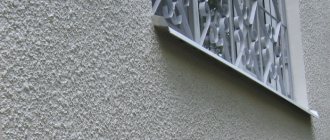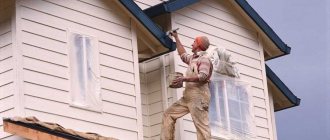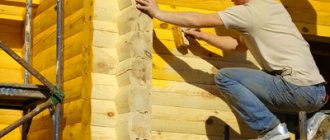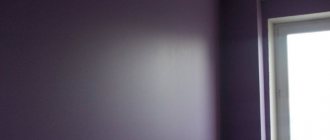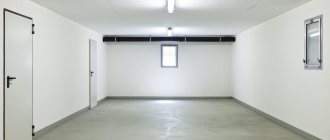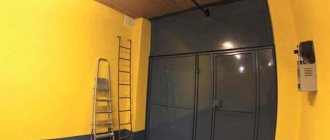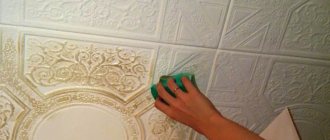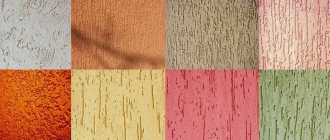The facades of houses are constantly exposed to the negative effects of atmospheric phenomena. With the onset of cold days, which are accompanied by rain or snow, the cladding material on the facades of buildings is destroyed. This especially applies to buildings that are finished with plaster mixtures.
To prevent destructive processes, the plastered surface must be additionally coated with paint. The technology of painting the facade will not cause any particular difficulties even for those who rarely carry out repair work in the house.
Criteria for choosing paint for the facade
Making your home more beautiful is probably how many first-time homeowners imagine the goal of painting.
In fact, painting facades achieves two goals:
- protection of walls from the damaging effects of the environment;
- satisfying aesthetic needs.
CMs form a layer of protective film on the surface. No matter how thin the paint layer may seem, the film material, including artificial or natural fillers, resists:
- UV component of sunlight;
- penetration of water into the plaster cover;
- favor of the wall by fungus, lichens, microorganisms;
- surface erosion;
- freezing (preventing the absorption of water, prevents tearing of the plaster in the cold);
- premature aging.
In addition, the colorful film allows the plaster and walls to “breathe”.
Make sure that the paint is recommended by the company for facade work (universal paint is also suitable).
There is no such thing as too much paint, but the thrifty owner is interested in knowing how to choose a paint that best suits the conditions of his home. Painting the facade of a house over plaster is not possible with all paints that are sold, and of those that are suitable, not all give the best result.
It is a mistake to believe that there is a universal coloring agent that is ideal for all operating conditions. Materials with different bases (solvent, modifying additives) differ in physical, chemical, and operational characteristics.
Characteristics important for painting and operation:
- resistance to atmospheric factors (temperature fluctuations, precipitation, etc.);
- resistance to ultraviolet spectrum of sunlight;
- hydrophobicity;
- degree of vapor permeability (affects the possibility of condensation accumulation under the film, as well as the degree of favorable conditions for microorganisms);
- resistance to biological attack by microfauna and microflora;
- rheology and viscosity (affect the possibility of uniform application of the paint layer);
- adhesiveness (characteristic of the adhesion strength of CM to the surface);
- drying speed (taken into account if several layers are applied);
- crack resistance or elasticity (the paint film must withstand the expansion and shrinkage of the plaster coating due to changes in external temperatures), an indicator that is important when painting new buildings that have yet to shrink;
- consumption (the value is directly related to the quality of the base - for rough surfaces the consumption will be higher);
- safety (toxicity, for example, in the case of using an organic solvent, fire hazard);
- content of binders (with a low content, which happens in inexpensive compounds, the service life is reduced);
- service life (determines the duration of the interval between cosmetic repairs);
- price.
General information
House paint is classified according to several characteristics:
- type of binder;
- color;
- manufacturer.
According to the type of binder, the paint composition for the home can be:
- solvent based;
- water based.
Water-based house paint is divided into:
- acrylate;
- acrylic;
- silicone.
Facade paint should enhance the building and not be afraid of exposure to aggressive environmental factors
How to paint the facade of a house after plastering
Paint for a plastered brick wall must have a high vapor permeability parameter. Porosity and resistance to alkaline environments are important for concrete.
Cover the wooden surface with moisture-resistant and elastic paint; however, a moisture-resistant and vapor-permeable material is suitable for any plastered base.
For plastered, wooden or concrete walls with obvious cracks, it is better to take crack-resistant rubber paint - it will perfectly hide defects or prevent their appearance.
There is a rule derived from experience: what kind of plaster base, what kind of paint base suits it. In addition, silicone or silicate CMs are suitable for lime-cement coatings; almost all types of paints are suitable for cement or lime-cement compositions.
Acrylic
Thanks to polymer compounds based on acrylic, it forms an elastic film resistant to mechanical stress. Resists bioaggressors, UV rays, as well as the formation of cracks due to microdeformations of walls. It is hydrophobic, but vapor permeable, which is important for wooden walls under plaster.
Manufacturers produce acrylic CM on organic (can be painted at temperatures down to -15°C) or water-dispersed bases. The most economical option for painting the facade. It fits well on various types of plasters, holds tenaciously, wears slightly, and is washable. Serves for more than 7 years.
Do not use over lime plaster coatings.
Silicone
The most “rubbery” is tensile paint. If the house has not yet gone through a period of shrinkage, it is the best option for painting. Also suitable for buildings erected near railway tracks, in seismic regions.
It is based on polymer compounds of silicone resins with a structure that is impermeable to water (the property is maintained regardless of the weather), but permeable to steam. They are even used for “capricious” lime plaster, which does not conflict with it. It is considered a guaranteed long-liver among CMs - it serves up to a quarter of a century without complaints.
Non-toxic, does not react to harmful atmospheric chemicals, and washes well. Does not accumulate static and dust. Expensive color option.
Silicate
Thanks to the liquid glass base, it has increased water resistance. Dirt from such a film is removed during rain. Easy to clean. Like silicone, it is not attractive to biota.
It “sticks” well to plastered surfaces and does not react to ultraviolet radiation or aggressive atmospheric chemicals. Non-flammable, non-toxic (except for the application phase), vapor permeable. Serves up to 20 years.
Minuses:
- more expensive than most KMs;
- inelastic (does not tolerate building shrinkage);
- “capricious” when applied (dexterity and skill are required);
- is not friends with the CM on any other basis;
- The components are mixed before painting.
Examples of silicate paints for facades
Cement
A mineral-based composition (white Portland cement + pigments) is often used by builders. The reason for this is the low price, inorganic (mineral) base, resistance to fire and weather influences. Forms a matte surface.
Surface preparation
Methods of painting facade walls.
The substrate for painting is cleaned of dirt, dust and excessive stains. If the new plaster is made of cement or lime, it is necessary to withstand a period of carbonation of the composition. It lasts about a month.
The strength of the plaster layer must be checked. The entire area is carefully tapped with a pick. The plaster is removed from weak areas. The cracks are sealed with concrete mortar.
The deep penetration primer is applied twice. The first layer will prevent moisture absorption and create a uniform texture of the plaster surface. The adhesion of the base will also improve.
The second coat of primer is applied a day later. Its purpose is to ensure good absorption of applied paint into the plaster. You can use special façade paints-primers, which contain polymer additives and quartz sand. In this case, there is no need to carry out a second surface treatment with a primer.
In order not to have to clean the paint from doors and windows, they should also be covered in advance with masking tape, which is easy to both stick and remove. In addition, it leaves no traces. A plastic film is laid under the wall.
If groundwater comes close to the house or the wall is in a shaded area, the primer layer is coated with an antifungal agent.
Tips for choosing colors
We recommend taking into account some criteria when choosing a color:
- the color of the walls and roof should be combined, therefore, if the color for the roof has not yet been finally decided, then painting the facade of the house in pastel colors over plaster is the best option for the walls;
- if the roof is dark in color, then the outer walls are painted in light colors;
- to make the house look more elegant, more dynamic, use two shades (for openings - lighter colors than for walls), the reverse combination is used less often, only after consulting with the designer;
- parts of the facade are distinguished either by the structure of the coating or by color (two means together are too much);
- you should take into account the style, as well as the design of the local area, its lighting, and the type of plants.
Decorating qualities of the dye
Choose a glossy or matte type dye. Each type has its own characteristic features. The gloss shines and looks bright. It repels dirt. It requires a particularly carefully leveled base. After all, the glossy layer does not hide defects on the wall well.
You can disguise flaws with matte paint. But the coating quickly becomes covered with dust. Manufacturers have developed compositions so that a hydrophobic film is created on the surface of the facade. She is capable of self-cleaning. Dust lingers on the walls and is later washed away by precipitation. The special property appears 30 days after applying the paint to the façade. In terms of hydrophobicity, the first place is occupied by silicone CM, the second by acrylic, and the third by silicate.
Based on these criteria and knowing the characteristics of each type of dye, you can select the desired option for facade decor. Taken together, the climate of the house’s location and the type of plaster are taken into account. For private homes, silicone CM remains the best option. This is effective protection against negative atmospheric influences and visually looks beautiful.
The nuances of painting the facade
Work should begin with painting areas that catch the eye during the initial examination. Be sure to protect window and door frames, as well as adjacent, previously painted areas.
Where paint does not reach during mechanical painting, and where it is difficult to paint with a roller, the wall is painted with a brush. To prevent dust from sticking to the long-drying paint, a film screen is made in front of the wall of the house.
Having chosen what to paint the facade of the house with plaster today, leave a note for yourself somewhere about what paint you used to paint the facade. Observe how the paint behaves during use. Inspect the property after 3-4 years. If the house looks like it was just painted, the paint was chosen correctly, the type is yours! Don't look for anything better for subsequent façade painting on plaster.
The process of painting external walls over plaster with your own hands
Before painting the outside of a plastered house, you need to select the necessary tools and prepare the base. And also, it should be taken into account that finishing work can be carried out at temperatures from +10-25 degrees in dry, windless weather.
What tools will you need?
Required tools:
- Spray gun, since the work area is large, manual painting will take a lot of time and effort.
- Rollers and brushes for processing joints and difficult places.
- Stepladder or scaffolding.
Preparing the surface for painting
At this stage, you need to plaster large cracks and irregularities. Next, the walls are covered with deep penetration primer to improve adhesion to the decorative finish. The impregnation is applied in two layers, allowing each layer to dry completely. It forms a film that prevents excessive absorption of paint into the base, which helps reduce material consumption.
Attention! If the paint does not have sufficient antibacterial properties, then the facade is treated with antiseptic impregnation.
Silicate
The basis is liquid glass, mineral elements and silicate filler. This paint coating provides good resistance to moisture and direct sunlight, and can last at least 25 years. In addition, walls painted with this material are not saturated with dampness.
But silicate paint also has some disadvantages. This is poor abrasion resistance and prone to chipping. The reason is that this coating is not elastic, so during operation it will certainly give negative results.
Tools for work
Having chosen what to paint the walls with, let’s consider what tool you will need for this. In addition to the paint itself, you will need:
- brush or roller for priming;
- two brushes for applying paint – one wide, for the main surface, the second, narrow, for hard-to-reach places; a wide brush can be replaced with a paint roller;
- to create a decorative surface (for example, grainy or patterned), you can use rollers with attachments;
- if necessary, color of the desired shade to dilute the white base;
- grater for polishing small irregularities;
- large capacity (tray);
- ladder;
- personal protective equipment: gloves, a respirator when using a spray gun, a hat when painting ceilings.
Manufacturers and product prices
Products used for painting facades:
- Akrial Lux;
- Expert;
- Optimist;
- Tikkurila;
- Farbitex;
- Symphony.
The average price per kg is 720 rubles. Taking into account the characteristics of the compositions, an option is purchased that will make the facade visually correspond to the parameters of beauty and be reliably protected from negative environmental conditions. Colors of ready-made options or independently obtained shades will help in creating the chosen artistic solutions.
Cement
Cement paint for external work contains mineral Portland cement and color additives. In terms of its properties, it completely replicates the characteristics of limestone. However, this type of facade plaster coating is more resistant to precipitation, but is not able to protect the surface from the effects of bacteria.
As practice has shown, fungus is often visible on walls coated with cement paint. Therefore, most owners of private houses do not use it to treat external surfaces. It is worth noting that the cost of this material is not high.
Decorative characteristics
Facade materials for finishing plastered surfaces must be susceptible to pigmentation. Products must be tinted in different shades.
Another important point is the ability to reflect light rays.
Based on this criterion, materials can be divided into matte, glossy and semi-gloss.
The most reliable, forming a dense film, are glossy facade paints that can transform the facade of a house. Surfaces finished with such materials get dirty less and are easy to clean. In the sun, surfaces glare, due to which small defects in the facade can be hidden. It is better to use matte and semi-matte paints.
Silicone
Silicone paint is considered the best among all facade coating options. Silicone water-based compositions are mainly produced. The outer surface of the house, painted with silicone material, acquires hydrophobic properties. All types of precipitation simply flow down the wall, never being absorbed into it.
At the same time, painted walls perfectly retain vapor permeability. The large number of micropores in the silicone layer does not retain moisture in the plastered wall, which can always breathe.
Silicone paint has excellent adhesion not only to plasters, but also to other surfaces. If you are interested in how to paint walls without plaster, you can safely use it. It is not the first year that it has received good reviews from consumers.
The paint coating is completely unaffected by high and low temperatures and ultraviolet radiation. At any time of the year, the facade of your house will look like new. The material is not electrified, so a lot of dust will not settle on the walls.
The biggest disadvantage of silicone-based products is their high cost, which far exceeds the cost of other paint products. In addition, it is slightly less elastic than acrylic.
Popular style solutions
Baroque - a delicate light palette, neutral tones, with a priority of cream, beige and light brown tones. Architectural elements should be lighter, the roof and base should be darker.
Note! We recommend visiting the portal https://gidrukodeliya.ru - there is a large selection of ideas for beginning craftswomen.
Modern - there are two varieties, the beginning of the twentieth century and the “modern” style. The choice of color depends on the design solution and style direction. This is the case where warm and cold colors can be organically combined.
Provence, chalets and other varieties of country style have one goal - to reflect the natural palette as much as possible. The priority is white, blue, green, terracotta and light blue tones.
Romanticism is a pleasant combination of two contrasting shades, close in color to natural stone. The roof may have a brighter design in the form of burgundy or green soft tiles.
Minimalism - this trend has several varieties, including urban and Scandinavian trends. But they have one thing in common - these styles have always been distinguished by moderation and a tendency towards a light palette.
The Japanese-style house features white walls and brown woodwork, but we have a different interpretation of Asian traditions. It is advisable to contact a professional designer.
Finding a harmonious combination is not so easy; you don’t always need to be guided by personal preferences. Moderation, good taste and expert recommendations will help you make the right choice of façade paint.
